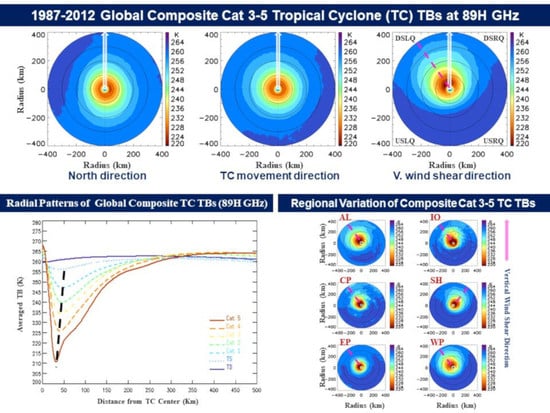Tropical Cyclone Climatology from Satellite Passive Microwave Measurements
Abstract
1. Introduction
2. Methodology and Datasets
3. Results
3.1. TC Structure Climatology
3.1.1. Global TC Annual Variability
3.1.2. Global TC Structure
3.1.3. Environmental Impact on TC Structure
3.2. Structure Differences Among TC Basins
3.2.1. Geographic Features of Environmental Impacts
3.2.2. Regional Characteristics of TC Structure
4. Discussion
5. Conclusions
Author Contributions
Funding
Acknowledgments
Conflicts of Interest
References
- Anthes, R.A. Tropical Cyclones: Their Evolution, Structure, and Effects. In Meteorological Monographs; American Meteorological Society: Boston, MA, USA, 1982; 208p. [Google Scholar] [CrossRef]
- Gray, W.M. The Formation of Tropical Cyclones. Meteorol. Atmos. Phys. 1998, 67, 37–69. [Google Scholar] [CrossRef]
- Blake, E.S.; Landsea, C.W.; Gibney, E.J. The Deadliest, Costliest, and Most Intense United States Tropical Cyclones from 1851 to 2010 (And Other Frequently Requested Hurricane Facts) (PDF) (NOAA Technical Memorandum NWS NHC-6); United States National Oceanic and Atmospheric Administration’s National Weather Service: Washington, DC, USA, 2011. [Google Scholar]
- Rappaort, E.N. Loss of life in the United States associated with recent Atlantic tropical cyclones. Bull. Amer. Meteor. Soc. 2000, 81, 2065–2074. [Google Scholar] [CrossRef]
- Knight, D.B.; Davis, R.E. Climatology of tropical cyclone rainfall in the southeastern United States. Phys. Geogr. 2007, 28, 126–147. [Google Scholar] [CrossRef]
- Yang, S.; Cossuth, J. Satellite remote sensing of tropical cyclones. Chapter 7 of Recent Developments. Trop. Cyclone Dyn. Predict. Detect. Intech 2016, 138–170. [Google Scholar] [CrossRef]
- Wimmers, A.J.; Velden, C.S. MIMIC: A New Approach to Visualizing Satellite Microwave Imagery of Tropical Cyclones. Bull. Amer. Meteor. Soc. 2007, 88, 1187–1196. [Google Scholar] [CrossRef]
- Hawkins, J.D.; Lee, T.F.; Turk, J.; Sampson, C.; Kent, J.; Richardson, K. Real-time internet distribution of satellite products for tropical cyclone reconnaissance. Bull. Amer. Meteor. Soc. 2001, 82, 567–578. [Google Scholar] [CrossRef]
- Kidder, S.Q.; Goldberg, M.D.; Zehr, R.M.; DeMaria, M.; Purdom, J.F.; Velden, C.S.; Grody, N.C.; Kusselson, S.J. Satellite analysis of tropical cyclones using the Advanced Microwave Sounding Uint (AMSU). Bull. Amer. Meteor. Soc. 2000, 81, 1241–1259. [Google Scholar] [CrossRef]
- Hawkins, J.D.; Turk, F.J.; Lee, T.F.; Richardson, K. Observations of tropical cyclones with the SSMIS. IEEE Trans. Geosci. Remote Sens. 2008, 46, 901–912. [Google Scholar] [CrossRef]
- Willoughby, H.E. Mature Structure and Evolution. In Chapter 2, Global Perspectives on Tropical Cyclones, WMO/TD-No. 693, Report No. TCP-38; World Meteorological Organization: Geneva, Switzerland, 1995. [Google Scholar]
- Dvorak, V.F. Tropical cyclone intensity analysis using satellite data. In NOAA Technical Report NESDIS; US Department of Commerce, National Oceanic and Atmospheric Administration: Silver Spring, MD, USA; Montgomery, AL, USA, 1984; Volume 11, pp. 1–47. [Google Scholar]
- Velden, C.S.; Olander, T.L.; Zehr, R.M. Development of an Objective Scheme to Estimate Tropical Cyclone Intensity from Digital Geostationary Satellite Infrared Imagery. Weather. Forecast. 1998, 13, 172–186. [Google Scholar] [CrossRef]
- Olander, T.L.; Velden, C.S. The advanced Dvorak technique: Continued development of an objective scheme to estimate tropical cyclone intensity using geostationary infrared satellite imagery. Weather Forecast. 2007, 22, 287–298. [Google Scholar] [CrossRef]
- Hawkins, J.; Velden, C. Supporting Meteorological Field Experiment Missions and Postmission Analysis with Satellite Digital Data and Products. Bull. Amer. Meteor. Soc. 2011, 92, 1009–1022. [Google Scholar] [CrossRef]
- Herndon, D.C.; Velden, C.S.; Hawkins, J.; Olander, T.; Wimmers, A. The CIMSS Satellite Consensus (SATCON) tropical cyclone intensity algorithm. In Proceedings of the 29th Conference on Hurricanes and Tropical Meteorology, Tucson, AZ, USA, 10–14 May 2010. [Google Scholar]
- Rogers, R.; Zhang, J.; Zawislak, J.; Jiang, H.; Alvey, G.R., III; Zipser, E.J.; Stevenson, S.N. Observations of the structure and evolution of Hurricane Edouard (2014) during intensity change. Part II: Kinematic structure and the distribution of deep convection. Mon. Weather Rev. 2016, 144, 3355–3376. [Google Scholar] [CrossRef]
- Rogers, R.; Reasor, P.D.; Zhang, J.A. Multiscale structure and evolution of Hurricane Earl (2010) during rapid intensification. Mon. Weather Rev. 2015, 143, 536–562. [Google Scholar] [CrossRef]
- Stevenson, S.N.; Corbosiero, K.L.; Molinari, J. The convective evolution and rapid intensification of Hurricane Earl (2010). Mon. Weather Rev. 2014, 142, 4364–4380. [Google Scholar] [CrossRef]
- Stevenson, S.N.; Corbosiero, K.L.; Abarca, S.F. Lightning in eastern North Pacific tropical cyclones: A comparison to the North Atlantic. Mon. Weather Rev. 2016, 144, 225–239. [Google Scholar] [CrossRef]
- Stevenson, S.N.; Corbosiero, K.L.; DeMaria, M.; Vigh, J.L. A 10-Year Survey of Tropical Cyclone Inner-Core Lightning Bursts and Their Relationship to Intensity Change. Weather Forecast. 2018, 60, 23–36. [Google Scholar] [CrossRef]
- Jiang, H.; Ramirez, E.M. Necessary conditions for tropical cyclone rapid intensification as derived from11 years of TRMM data. J. Clim. 2013, 26, 6459–6470. [Google Scholar] [CrossRef]
- Zagrodnik, J.P.; Jiang, H. Rainfall, convection, and latent heating distributions in rapidly intensifying tropical cyclones. J. Atmos. Sci. 2014, 71, 2789–2809. [Google Scholar] [CrossRef]
- Tao, C.; Jiang, H. Distributions of shallow to very deep precipitation–convection in rapidly intensifying tropical cyclones. J. Clim. 2015, 28, 8791–8824. [Google Scholar] [CrossRef]
- Tao, C.; Jiang, H.; Zawislak, J. The relative importance of stratiform and convective rainfall in rapidly intensifying tropical cyclones. Mon. Weather Rev. 2017, 145, 795–809. [Google Scholar] [CrossRef]
- Fischer, S.F.; Tang, B.H.; Corbosiero, K.L. Normalized convective characteristics of tropical cyclone rapid intensification events in the North Atlantic and Eastern North Pacific. Mon. Weather Rev. 2018, 146, 1133–1155. [Google Scholar] [CrossRef]
- Fischer, S.F.; Tang, B.H.; Corbosiero, K.L. A climatological analysis of tropical cyclone rapid intensification in environments of upper-tropospheric troughs. Mon. Weather Rev. 2019, 147, 3693–3719. [Google Scholar] [CrossRef]
- Chen, S.S.; Knaff, J.A.; Marks, F.D. Effects of vertical wind shear and storm motion on tropical cyclone rainfall asymmetries deduced from TRMM. Mon. Weather Rev. 2006, 134, 3190–3208. [Google Scholar] [CrossRef]
- Lonfat, M.; Marks, F.D.; Chen, S. Precipitation distribution in tropical cyclones using the Tropical Rainfall Measuring Mission (TRMM) microwave imager: A global perspective. Mon. Weather Rev. 2004, 132, 1645–1660. [Google Scholar] [CrossRef]
- SHIPS. Available online: http://rammb.cira.colostate.edu/research/tropical_cyclones/ships/index.asp. (accessed on 31 October 2020).
- Yang, S.; Hawkins, J.; Richardson, K. The improved NRL tropical cyclone monitoring system with a unified microwave brightness temperature calibration scheme. Remote Sens. 2014, 6, 4563–4581. [Google Scholar] [CrossRef]
- Wimmers, A.J.; Velden, C.S. Advancements in objective multisatellite tropical cyclone center fixing. J. Appl. Meteor. Climatol. 2016, 55, 197–212. [Google Scholar] [CrossRef]
- Wimmers, A.J.; Velden, C.S. Objectively determining the rotational center of tropical cyclones in passive microwave satellite imagery. J. Appl. Meteor. Climatol. 2010, 49, 2013–2034. [Google Scholar] [CrossRef]
- Poe, G.A. Optimum interpolation of imaging microwave radiance data. IEEE Trans. Geosci. Remote Sens. 1990, 28, 800–810. [Google Scholar] [CrossRef]
- DeMaria, M.; Mainelli, M.; Shay, L.K.; Knaff, J.A.; Kaplan, J. Further Improvements in the Statistical Hurricane Intensity Prediction Scheme (SHIPS). Weather Forecast. 2005, 20, 531–543. [Google Scholar] [CrossRef]
- Knaff, J.; Sampson, C.; DeMaria, M. An Operational Statistical Typhoon Intensity Prediction Scheme for the Western North Pacific. Weather Forecast. 2005, 20, 688–699. [Google Scholar] [CrossRef]
- NOAA. Saffir-Simpson Hurricane Scale Information, National Hurricane Center. Available online: http://www.nhc.noaa.gov/aboutsshws.php (accessed on 5 December 2016).
- WMO. Regional Association IV Hurricane Operational Plan 2015, World Meteorological Organization Technical Document, 109p. Available online: https://www.wmo.int/pages/prog/www/tcp/documents/OPERATIONALPLAN2015_en_final.pdf. (accessed on 2 November 2020).
- Leighton, H.; Gopalakrishnan, S.; Zhang, J.; Rogers, R.F.; Zhang, Z.; Tallapragada, V. Azimuthal Distribution of Deep Convection, Environmental Factors, and Tropical Cyclone Rapid Intensification: A Perspective from HWRF Ensemble Forecasts of Hurricane Edouard (2014). J. Atmos. Sci. 2018, 75, 275–295. [Google Scholar] [CrossRef]
- Nguyen, L.T.; Rogers, R.F.; Reasor, P.D. Thermodynamic and Kinematic Influences on Precipitation Symmetry in Sheared Tropical Cyclones: Bertha and Cristobal (2014). Mon. Weather Rev. 2017, 145, 4423–4446. [Google Scholar] [CrossRef]
- Yu, Z.; Wang, Y.; Xu, H. Observed rainfall asymmetry in tropical cyclone making landfall over China. J. Appl. Meteor. Climatol. 2015, 54, 117–136. [Google Scholar] [CrossRef]
- Alvey, R.G., III; Zawislak, J.; Zipser, E. Precipitation properties observed during tropical cyclone intensity change. Mon. Weather Rev. 2015, 143, 4476–4492. [Google Scholar] [CrossRef]
- Rogers, R.F.; Marks, F.D.; Marchok, T. Tropical cyclone rainfall. In Encyclopedia of Hydrological Sciences; Anderson, M.G., Ed.; John Wiley and Sons: Chicester, UK, 2009. [Google Scholar]
- Yang, S.; Lao, V.; Bankert, R.; Whitcomb, T.R.; Cossuth, J. Improved Climatology of Tropical Cyclone Precipitation from Satellite Passive Microwave Measurements. J. Clim. 2020. (In Revision) [Google Scholar]
- Black, M.L.; Gamache, J.F.; Marks, F.D.; Samsury, C.E.; Willoughby, H.E. Eastern Pacific Hurricanes Jimana of 1991 and Olivia of 1994: The effect of vertical shear on structure and intensity. Mon. Weather Rev. 2002, 130, 2291–2312. [Google Scholar] [CrossRef]
- Corbosiero, K.L.; Molinari, J. The effects of vertical wind shear on the distribution of convection in tropical cyclones. Mon. Weather Rev. 2002, 130, 2110–2123. [Google Scholar] [CrossRef]
- Corbosiero, K.L.; Molinari, J. The relationship between storm motion, vertical wind shear, and convective asymmetries in tropical cyclones. J. Atmos. Sci. 2003, 60, 366–376. [Google Scholar] [CrossRef]
- Shapiro, L.J. The asymmetric boundary layer flow under a translating hurricane. J. Atmos. Sci. 1983, 40, 1984–1998. [Google Scholar] [CrossRef]
- McTaggart-Cowan, R.; Galarneau, T.J.; Bosart, L.F.; Moore, R.W.; Martius, O. A global climatology of baroclinically influenced tropical cyclogenesis. Mon. Weather Rev. 2013, 141, 1963–1989. [Google Scholar] [CrossRef]
- Wu, L.; Zong, H.; Liang, J. Observational analysis of tropical cyclone formation associated with monsoon gyres. J. Atmos. Sci. 2013, 70, 1023–1034. [Google Scholar] [CrossRef]
- Berg, W.; Bilanow, S.; Chen, R.; Datta, S.; Draper, D.; Ebrahimi, H.; Farrar, S.; Jones, W.L.; Kroodsma, R.; McKague, D.; et al. Intercalibration of the GPM microwave radiometer constellation. J. Atmos. Ocean. Technol. 2016, 33, 2639–2654. [Google Scholar] [CrossRef]
- Zhang, F.; Tao, D. Effects of vertical wind shear on the predictability of tropical cyclones. J. Atmos. Sci. 2013, 70, 975–983. [Google Scholar] [CrossRef]

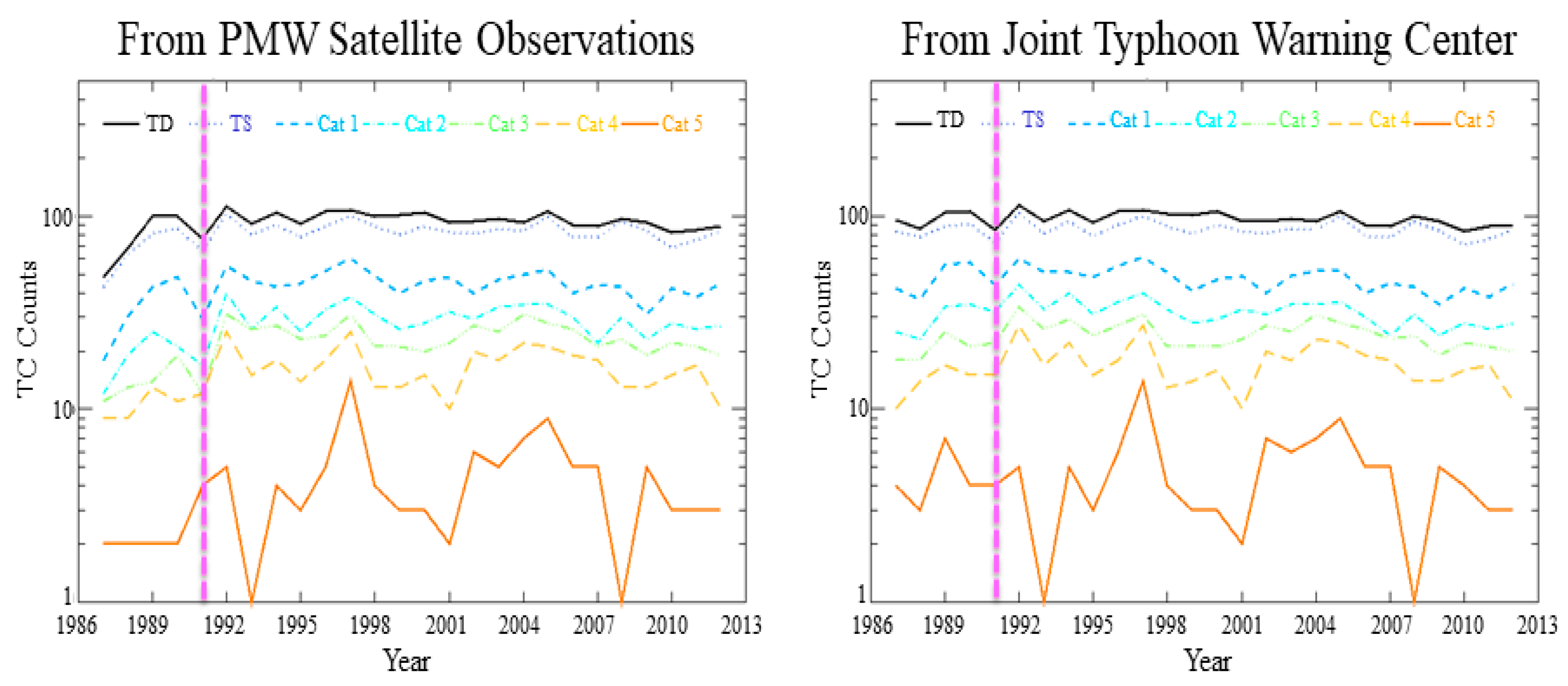
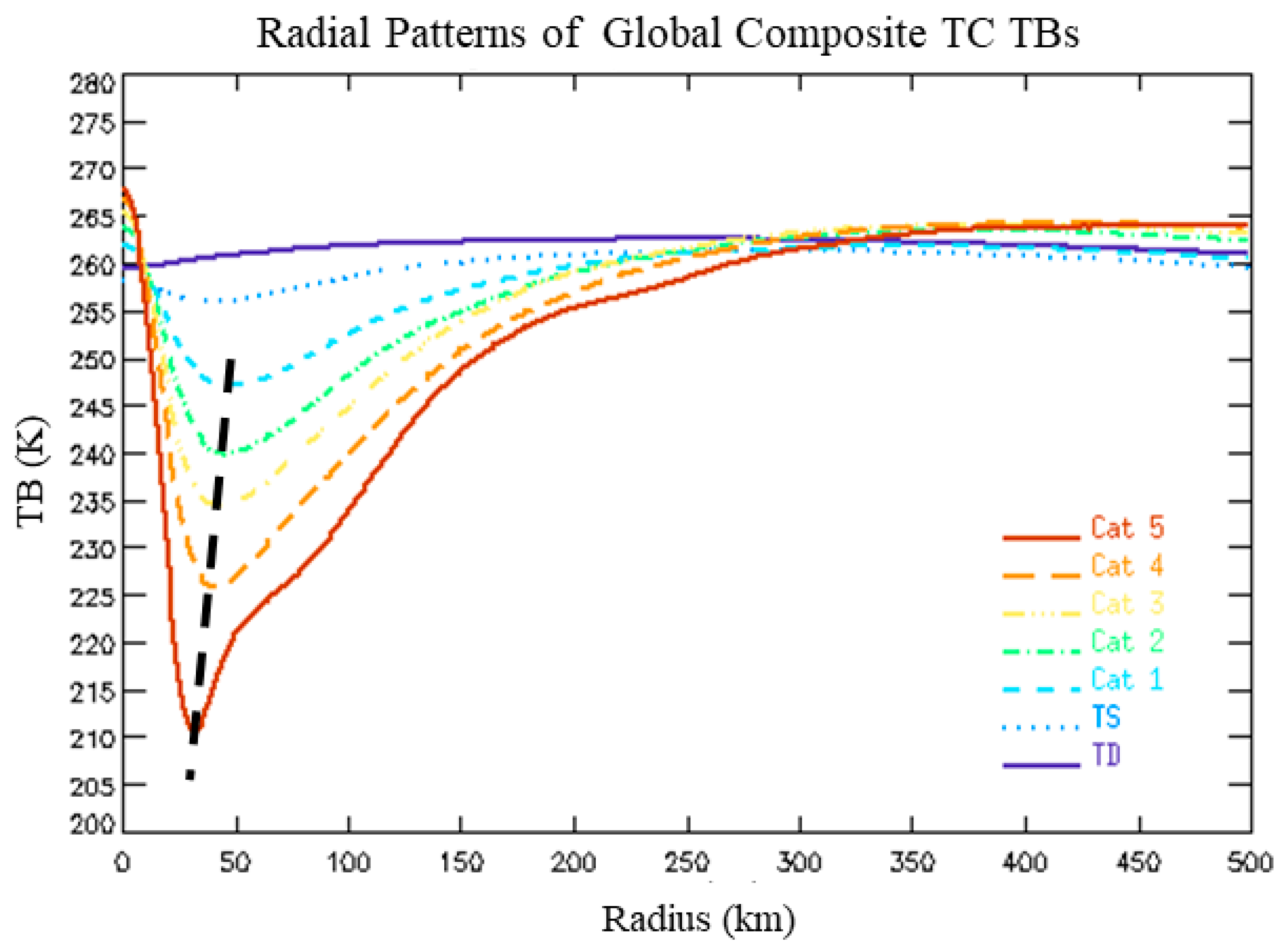

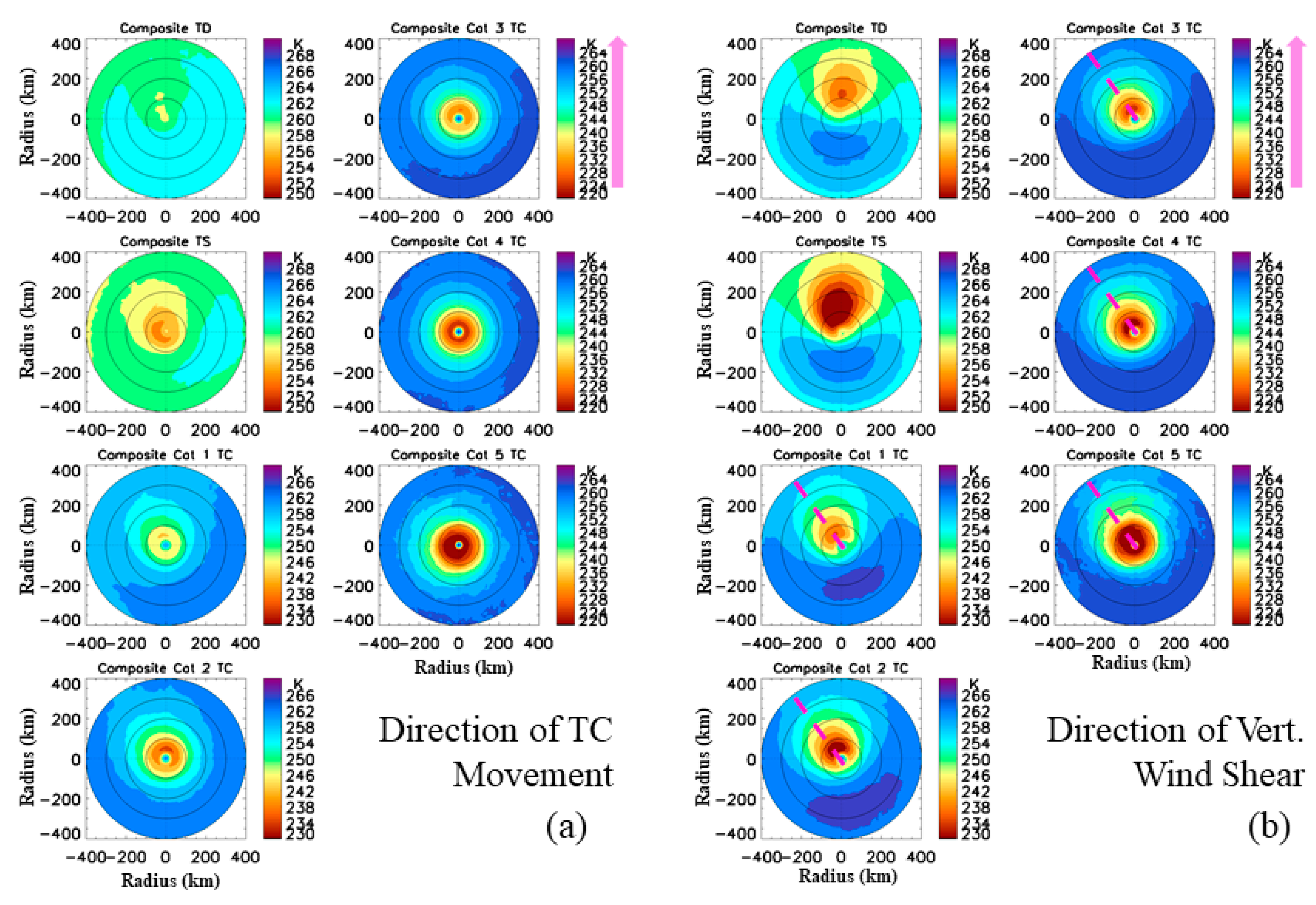
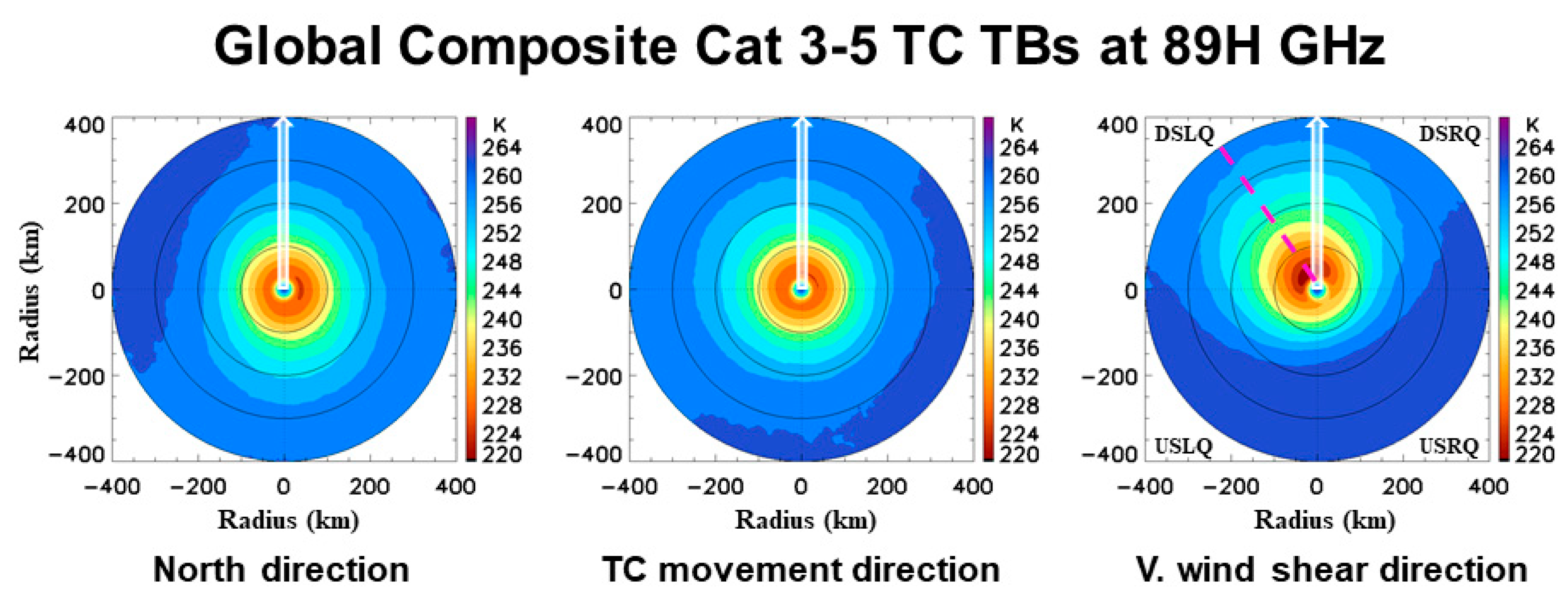

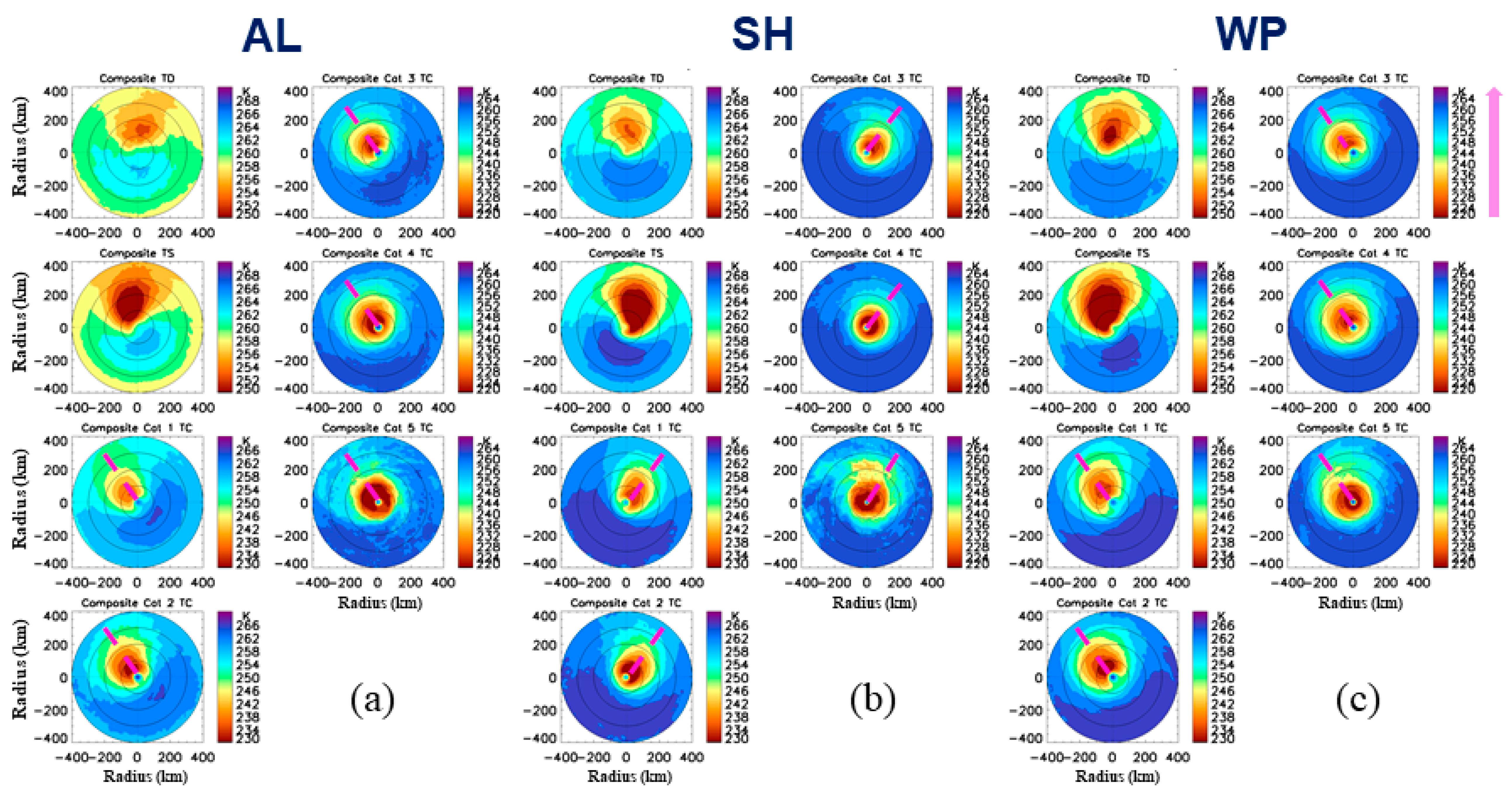



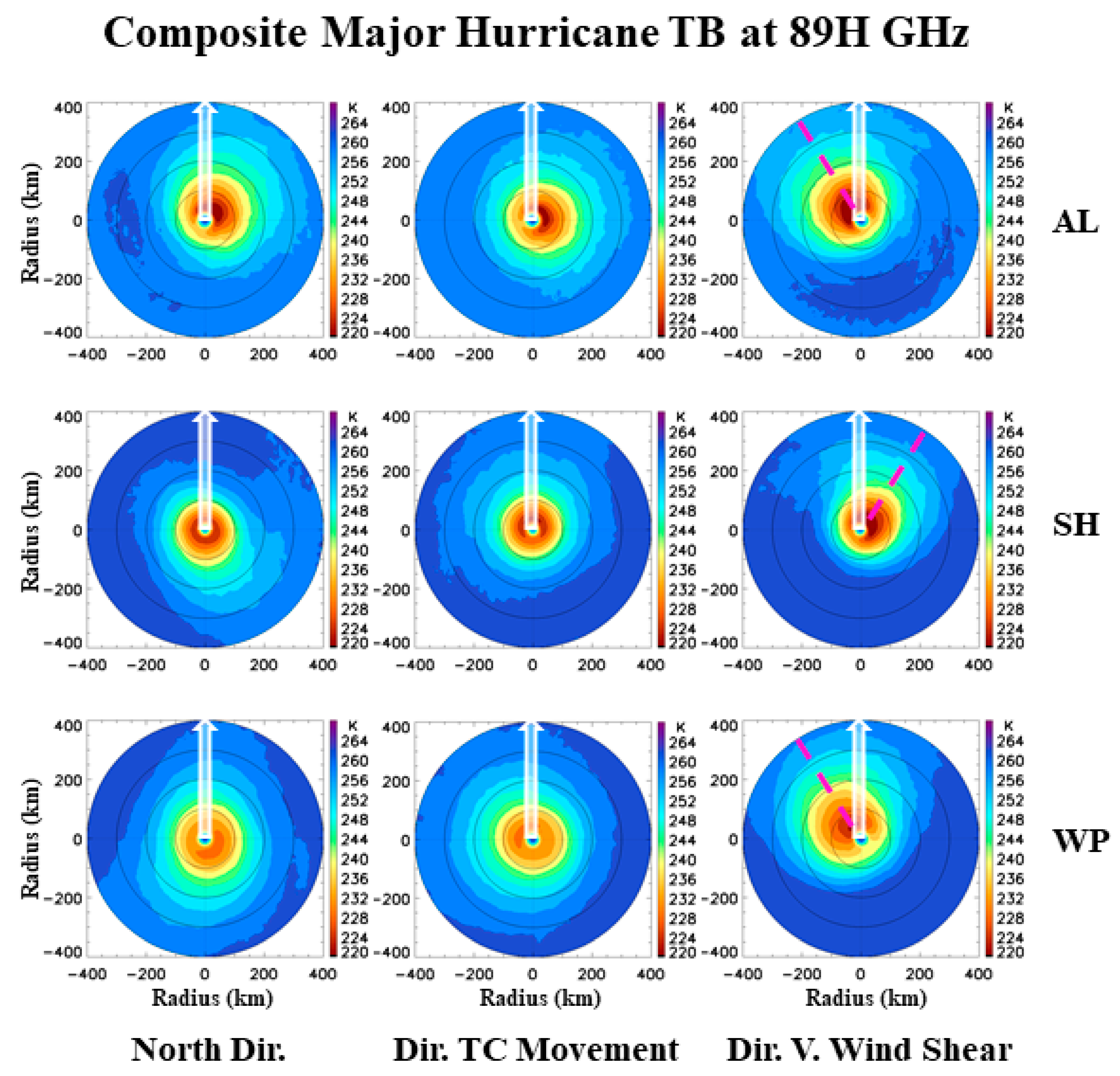
| TD | TS | Cat 1 | Cat 2 | Cat 3 | Cat 4 | Cat 5 | |
|---|---|---|---|---|---|---|---|
| AL | 4909 | 7832 | 2195 | 749 | 548 | 461 | 74 |
| CP | 785 | 332 | 129 | 68 | 85 | 94 | 47 |
| EP | 6016 | 4633 | 1178 | 574 | 497 | 355 | 44 |
| IO | 2025 | 1353 | 159 | 48 | 81 | 61 | 17 |
| SH | 10,225 | 8685 | 2174 | 1026 | 1025 | 726 | 79 |
| WP | 11,718 | 8794 | 3101 | 1699 | 1418 | 1520 | 354 |
| Total | 35,678 | 31,629 | 8936 | 4164 | 3654 | 3217 | 615 |
| TD | TS | Cat 1 | Cat 2 | Cat 3 | Cat 4 | Cat 5 | |
|---|---|---|---|---|---|---|---|
| AL | 5.4 | 6.7 | 6.9 | 5.8 | 6.1 | 5.7 | 5.6 |
| CP | 4.9 | 5.5 | 6.0 | 3.9 | 4.6 | 5.0 | 4.9 |
| EP | 4.2 | 4.5 | 4.6 | 4.8 | 5.0 | 5.2 | 6.3 |
| IO | 3.6 | 3.8 | 3.8 | 4.4 | 4.0 | 4.1 | 5.9 |
| SH | 4.0 | 4.7 | 4.4 | 4.5 | 4.5 | 4.1 | 4.1 |
| WP | 4.9 | 6.0 | 6.0 | 5.5 | 5.4 | 5.2 | 5.3 |
| TD | TS | Cat 1 | Cat 2 | Cat 3 | Cat 4 | Cat 5 | |
|---|---|---|---|---|---|---|---|
| AL | 8.5 | 9.4 | 9.9 | 8.4 | 8.0 | 6.7 | 5.8 |
| CP | 6.0 | 7.4 | 7.5 | 7.3 | 5.6 | 5.6 | 5.7 |
| EP | 7.3 | 6.4 | 5.5 | 5.4 | 4.8 | 4.5 | 4.4 |
| IO | 9.0 | 9.1 | 6.8 | 6.5 | 5.6 | 6.6 | 6.8 |
| SH | 8.3 | 8.9 | 8.2 | 7.4 | 7.6 | 6.0 | 5.4 |
| WP | 7.9 | 8.0 | 7.8 | 7.5 | 7.4 | 5.6 | 4.7 |
| Basin. | Motion Vector | TD | TS | Cat 1 | Cat 2 | Cat 3 | Cat 4 | Cat 5 |
|---|---|---|---|---|---|---|---|---|
| AL | Speed | 2.4 | 3.0 | 4.1 | 3.4 | 4.2 | 4.9 | 5.2 |
| Direction | 323.7 | 9.7 | 15.0 | 344.8 | 328.7 | 302.3 | 289.2 | |
| CP | Speed | 3.7 | 2.6 | 5.1 | 3.4 | 4.0 | 4.5 | 4.7 |
| Direction | 277.5 | 317.7 | 306.0 | 315.5 | 316.0 | 296.7 | 274.1 | |
| EP | Speed | 3.0 | 3.7 | 4.0 | 4.0 | 4.4 | 4.8 | 5.0 |
| Direction | 287.0 | 295.7 | 296.7 | 297.6 | 294.2 | 291.1 | 296.4 | |
| IO | Speed | 2.2 | 2.2 | 2.1 | 3.4 | 3.0 | 3.2 | 5.1 |
| Direction | 303.5 | 324.2 | 348.2 | 1.5 | 10.5 | 356.2 | 342.9 | |
| SH | Speed | 1.8 | 2.3 | 2.4 | 2.6 | 2.5 | 2.4 | 2.5 |
| Direction | 225.2 | 185.1 | 191.4 | 186.0 | 191.5 | 212.5 | 206.5 | |
| WP | Speed | 2.9 | 3.1 | 3.4 | 3.3 | 3.5 | 3.8 | 4.5 |
| Direction | 308.5 | 349.7 | 345.8 | 340.5 | 339.2 | 323.4 | 309.4 |
| Basin | Wind Shear Vector | TD | TS | Cat 1 | Cat 2 | Cat 3 | Cat 4 | Cat 5 |
|---|---|---|---|---|---|---|---|---|
| AL | WindShear | 4.7 | 6.1 | 7.1 | 5.5 | 5.4 | 4.5 | 4.0 |
| Direction | 93.5 | 91.5 | 75.7 | 79.7 | 79.2 | 77.3 | 94.8 | |
| CP | WindShear | 2.0 | 3.7 | 5.4 | 5.6 | 4.5 | 2.4 | 5.6 |
| Direction | 77.8 | 68.5 | 54.0 | 74.8 | 59.6 | 109.6 | 157.2 | |
| EP | WindShear | 0.3 | 0.6 | 0.8 | 0.6 | 0.7 | 1.3 | 2.2 |
| Direction | 345.8 | 255.7 | 252.9 | 277.0 | 288.2 | 258.4 | 94.7 | |
| IO | WindShear | 6.1 | 6.2 | 4.0 | 3.8 | 3.6 | 3.1 | 4.5 |
| Direction | 300.1 | 299.6 | 297.8 | 281.7 | 260.1 | 324.2 | 17.3 | |
| SH | WindShear | 8.3 | 8.9 | 8.2 | 7.4 | 7.6 | 6.0 | 5.4 |
| Direction | 135.2 | 123.1 | 119.6 | 121.1 | 117.8 | 126.9 | 89.9 | |
| WP | WindShear | 2.5 | 1.5 | 0.9 | 1.0 | 2.0 | 0.8 | 1.1 |
| Direction | 226.9 | 197.3 | 130.4 | 122.9 | 81.5 | 156.0 | 186.4 |
Publisher’s Note: MDPI stays neutral with regard to jurisdictional claims in published maps and institutional affiliations. |
© 2020 by the authors. Licensee MDPI, Basel, Switzerland. This article is an open access article distributed under the terms and conditions of the Creative Commons Attribution (CC BY) license (http://creativecommons.org/licenses/by/4.0/).
Share and Cite
Yang, S.; Bankert, R.; Cossuth, J. Tropical Cyclone Climatology from Satellite Passive Microwave Measurements. Remote Sens. 2020, 12, 3610. https://doi.org/10.3390/rs12213610
Yang S, Bankert R, Cossuth J. Tropical Cyclone Climatology from Satellite Passive Microwave Measurements. Remote Sensing. 2020; 12(21):3610. https://doi.org/10.3390/rs12213610
Chicago/Turabian StyleYang, Song, Richard Bankert, and Joshua Cossuth. 2020. "Tropical Cyclone Climatology from Satellite Passive Microwave Measurements" Remote Sensing 12, no. 21: 3610. https://doi.org/10.3390/rs12213610
APA StyleYang, S., Bankert, R., & Cossuth, J. (2020). Tropical Cyclone Climatology from Satellite Passive Microwave Measurements. Remote Sensing, 12(21), 3610. https://doi.org/10.3390/rs12213610



